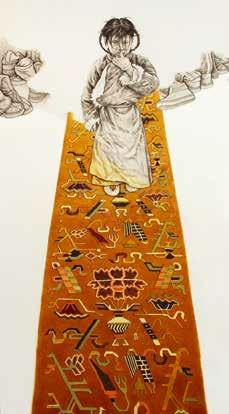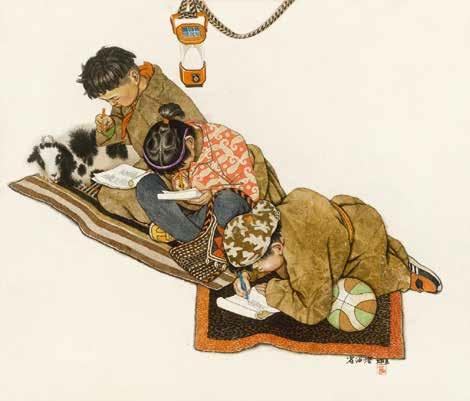The Tibetan Transplant
2020-09-30byHanShuli
by Han Shuli

Although I was born and grew up in Beijing, I stayed in Tibet for a much longer time—47 years, to be exact. For this reason, I think of myself as a Tibetan and call Tibet home.
Before the age of 25, I never thought much about Tibet. Before the autumn of 1973, my only memory about that place was a visit to the Cultural Palace of Nationalities for a school trip, during which we got a glimpse of brutal serfdom in old Tibet. I never imagined that fate would take me from Heilongjiang Province, the furthest northeastern corner of China, to the snowy plateau in southwestern China, where I would live and work happily for over four decades.
The water and mountains in Tibet are beautiful. This was my first impression of this place. Statuesque Tibetan figures attracted me like magnets as if they were born to be painted and sketched on canvas. When I first arrived, I was excited all day long. In those days, it felt like I could sit down in any random place and find a stunning subject to paint. I never cared about sitting in mud or walking through puddles.
I once continued drawing even as I was engulfed by a sea of curious children. As they slowly dispersed, I was suddenly hit on the waist by a stone. I first thought that it was a prank by a Tibetan child. But I looked around and didnt see any children at all. I saw a couple of local women walking by, carrying wheat straw on their backs. One of them pointed to where I was sitting, and only then did I realize that the ice under my body had melted and soaked most of my pants. The rock was their way of kindly letting me know! I felt grateful immediately. Decades later, I still remember the warm flying stone.
In the 1980s, all aspects of Tibetan social life greatly improved after the reform and opening-up policy was introduced. My new employer, the Tibetan branch of the China Federation of Literary and Art Circles, was able to rent a “Jiefang” truck to take a group of five people to Tibets Ngari Prefecture so we could study the art of the Guge Kingdom.
Although the driver Dorje was only 19 years old and the car was very old, we still chased the sun westward enthusiastically every day. At the Maquan River near Ngari, our vehicle got stuck. We were in the middle of nowhere. The painter Bama Tashi and the driver had to walk back to Zhongba County for help, dozens of kilometers away. The rest of us stayed at the riverside to watch the car, catch fish, collect firewood, and wait for help with a bag of instant noodles as our daily meal.

A full week later, reinforcements finally arrived: 21 strong, singing Tibetans and a dump truck. They all jumped into the chilly river before their truck even stopped to tie steel cables and dig the tires out. They worked together to pull the car out of the mud. We were so overcome with the joy and excitement of being rescued from the dangerous situation that we couldnt find the words to thank them. Words were insufficient. A smart young man surnamed Zhai offered the half pack of cigarettes he had left, and Abu hurriedly handed out White Rabbit candies. All I could do was to take a few color photos of the 21 saviors, which were still rare at the time. We waved goodbye as they left. None of them mentioned money—neither compensation for their labor nor the gasoline. Although this happened 31 years ago, I still regularly ponder how those men must have considered kinship invaluable and unable to be measured with money.
Tsangyang Gyatso, the 6th Dalai Lama and a famous poet who lived over three hundred years ago, wrote a poem that goes: “Those who never meet wont ever know each other, and those who dont know each other will never miss each other.”
Four decades ago, an ordinary Han youth first met Tibet, Tibetan people, and their culture, and ever since, he has been continuously blessed, accepted, and influenced by them. What a life! This is my relationship with Tibet in a nutshell. I have gained a broader vision and a more open mind by living on the plateau and overcoming its nature to enjoy the beauty under both Han and Tibetan cultures for decades. I would be happy to spend the rest of my life climbing the holy snow-capped mountains on the plateau and creating better art.